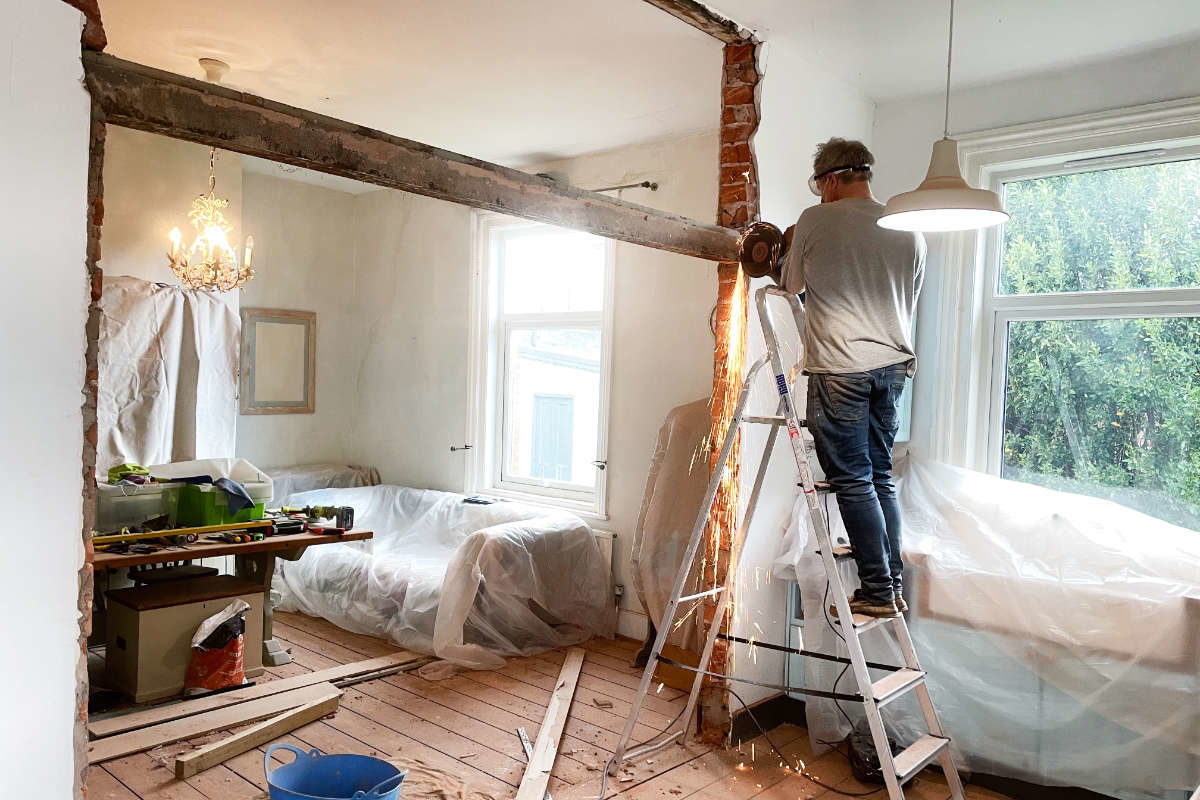Knocking through an internal wall is a fantastic way to open up your living space, create an open-plan kitchen/diner, or utilise a new extension to maximise your lounge.
Traditionally, properties were designed with multiple smaller rooms rather than an open plan style. A wall can be demolished to turn dark, unused spaces into one more generous area.
However, you must understand whether a wall is load-bearing or not, check for electrical wiring or plumbing pipework, and think carefully about the finished design before you break out the hammer.
1. Is the Wall Load Bearing?
Your first task is to check if the wall is load-bearing. That means it has a beam running along the top of the wall that supports the storey above.
Knocking down a load-bearing wall is always a job for a professional because if the structure isn’t properly supported (including during the work), your upper level could collapse.
It’s not always obvious whether a wall is load-bearing – and tapping on the wall isn’t a sure fire way of checking!
Rather, you should consult a contractor, architect or structural engineer, who will look at your property plans and see how the house is supported.
2. Does the Wall Have a Supporting Beam?
A load-bearing wall has a support beam or RSJ specifically designed to distribute weight pressure and keep the internal walls in your home stable. You can knock the wall through, but it must be replaced with the right size, length and density beam.
Building regulations apply to all building work, and you’ll normally need a structural engineer who can verify the required specification of the beam.
Fitting a steel beam involves a detailed calculation of the property dimensions, materials and weights; there isn’t one standard-sized beam used in all domestic properties.
The local Building Control Inspector must review those technical details before work begins.
You cannot fit a beam or RSJ yourself – the wall is supported with a range of props that keep it stable until the new beam is in place and can bear the weight.

3. Are There Electrics or Plumbing Inside the Wall?
Next, you need to check whether any utilities are running through the wall – plumbing pipes, gas lines or electricity cables.
Contractors will not knock down a wall and check for cables as they go but will look at the location of switches, sockets and connections. It is less common to have pipes in the walls (these are usually located under the floor) but still important to confirm.
Knocking through and damaging an electrical cable can be extremely dangerous and difficult to fix – it is far better to have a contractor inspect the wall and recommend re-routing options before work begins.
They will often use a cable detector to locate the exact position of wires, frames and other materials hidden behind a wall.
4. Do You Need Building Regulation Consent?
Most internal decorating projects, such as knocking down an interior wall, do not need full planning permission unless your property is listed or has other restrictions on the alterations you can make.
You will need Building Regulations approval, regardless of the size of the project, whether you are knocking a wall down completely or knocking through part of a wall to install a new doorway.
Inspectors attend the site and verify the specification if the wall is load-bearing. Their role is to confirm that the work is compliant with safety standards and issue a completion certificate if they are happy with the work.
Some contractors can self-certify the quality of their work; alternatively, they can liaise with the Building Control Inspector where required.
The certification is essential if you come to sell your home, as it proves that the work was approved and is legally valid – knocking through a wall without this documentation could mean that your insurance is invalid.
5. Is the Wall Connected to a Neighbouring Property?
In most cases, you’ll only need to think about party walls if you are demolishing an external wall that is common between two properties. However, party wall regulations apply if the support beam above a load-bearing wall runs between your homes.
Again, that doesn’t mean you can’t proceed, but you’ll need consent from your neighbour or to contact a Party Wall Surveyor to draw up an agreement on your behalf.
6. Will You Need to Redecorate the Floor or Ceiling?
The surfaces above and underneath your wall will need to be decorated once the wall has been removed. You will usually have bare brick walls on either side, too, since these will have previously been hidden underneath the wall.
Contractors might include ‘making good’ within their quote, although you should clarify what this involves – that usually means patching over the exposed area or applying a new layer of plaster.
Some wall demolition projects result in minor cracks above the old wall due to the impact, so you should ensure you have a budget available to repair the surrounding areas.
Likewise, if you are knocking through to create a large kitchen/diner, you will need to factor in re-tiling, new laminate flooring or replacing the floor surfacing throughout both rooms once your wall has been knocked through.

